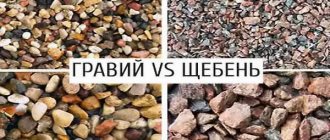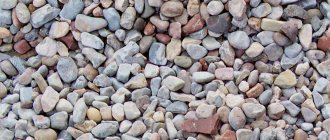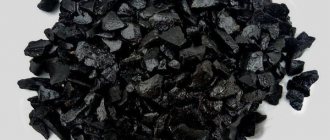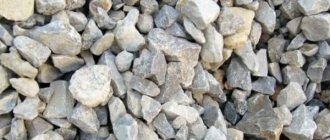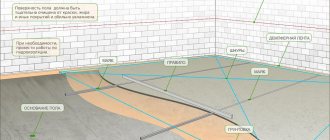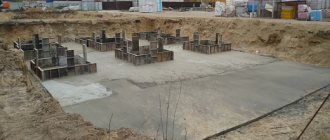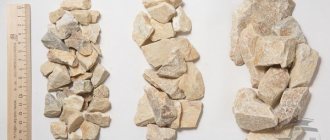Despite the fact that gravel and crushed stone are very similar, they are two fundamentally different materials. However, they are often confused with each other.
Let's figure out the difference between gravel and crushed stone and which is better. After reading this article, you will learn to visually distinguish these materials from each other.
First, we need to clarify that gravel is a sedimentary rock. This type includes a whole group of rocks, including clastic rocks.
This is what this classification looks like:
Classification of clastic rocks
| Type of rock and size of its fragments | Breed name | |||
| Unrounded varieties | Rounded varieties | |||
| Loose | Cemented | Loose | Cemented | |
| Rough (> 2 mm) | Blocks, crushed stone, debris | Breccia | Boulders, pebbles, gravel | Conglomerates |
| Sandy (2-0.05 mm) | Sands | Sandstones | — | — |
| Dusty (0.05-0.005 mm) | Loams | Siltstones | — | — |
| Clayey ( | Clays | Agrillites | — | — |
As you can see, both crushed stone and gravel belong to clastic rocks. But they have a number of differences. Let's look at them in more detail.
Areas of application
In addition to the main characteristics by which these building materials are classified, they also have other properties: frost resistance, flakiness, abrasion, strength, etc. They affect both cost and scope of application.
In principle, crushed stone can be used not only in construction. It, like gravel, is suitable for filling a yard, for paths and parking in a country house, etc. But it is necessary to take into account all the characteristics of the selected material.
If we consider such a parameter as frost resistance (usually denoted by the letter F), then it shows how many cycles of freezing and thawing the building material can withstand. Naturally, those brands with a higher F index will be more expensive.
Granite crushed stone is considered the most durable; it is suitable for foundations, industrial highways, and airports. You can also use it for a parking lot if large vehicles will be parked there.
Carefully! He can make noise! It is better to buy it with a dosimeter.
The density of natural rock is usually lower. Due to exposure to natural phenomena, such pebbles are more fragile. In some cases, you can simply crumble them by hand. But they are also used in almost all areas: they build gravel roads, fill parking lots, use them in landscape design, etc.
Extraction method
Gravel is a raw material of natural origin, and crushed stone is a product of mechanical crushing of rock. And this is one of the main differences; in fact, all other differences follow from it.
We will not discuss mining technologies in detail in this article. You can read about them in the articles How gravel is mined and Crushed stone production.
But here we’ll just say that gravel was formed as a result of long processes of destruction of rocks under the influence of the sun, precipitation, and weathering. In contrast, crushed stone was obtained from a solid rock mass by crushing.
Features and characteristics of crushed stone
Crushed stone is a bulk material that is mined by crushing or natural methods. The mixture can be extracted from closed and open quarries, after which it is thoroughly cleaned. All these operations are performed depending on the method of obtaining particle sizes, or fractions.
The grain diameter will directly affect the price at which crushed stone is sold, as well as the scope of use. Crushed stone is divided into several varieties, but in any case it remains a bulk material that has approximately the same size, shape and chemical composition of the granules.
The main characteristic is the extraction method. Thermal conductivity, frost resistance, and adhesion will depend on this. Crushed stone can be:
- Granite, which is the most expensive option. It is obtained by crushing and sifting granite rocks.
- Crushed gravel is the most popular type, which is used in various types of construction. Obtained from rocks of medium hardness.
- Crushed limestone is the cheapest option, which is obtained after processing mined pieces of limestone. The structure of the material is quite porous, and therefore cannot withstand high loads, but the material has good frost resistance.
What granite crushed stone looks like
There are many basic indicators of this bulk material. A special role is played by frost resistance, as well as radioactivity of crushed stone. The first indicator is important because it determines at what temperatures different brands can be used. The second indicator indicates how safe the material is for humans and the environment. The main characteristics are fractionality and flakiness, since they determine the scope, as well as the price at which the material can be sold.
Crushed stone is divided into several main groups according to the size of the granules. Small ones have a diameter from 5 to 20 mm, medium ones - 20-40, large ones - 40-70. The most versatile option is the small and medium type.
Crushed stone is also divided into several groups of flakiness -15, 25, 35, and up to 50%. The lower this indicator, the more expensive the material will cost.
Grain structure
Since the gravel was on the surface of the earth for a long time and exposed to the atmosphere, it preserved the characteristics of the original rock much less well. The crushed stone is crushed in a quarry and immediately sent for sale. Therefore, its structure is much more pronounced.
Let's look at the photo again:
What is dropout?
Not everyone knows about the existence of such material, but thanks to it, they save on some stages of construction, because the raw material costs less than gravel and pebbles. Screenings are natural by-products that result from the production of crushed gravel, granite or limestone. During the extraction of the material, about 40% of such waste is obtained, so over time they also found use.
Since the screenings contain a lot of dust, they are pre-washed; this procedure improves the characteristics. After this, the cost of raw materials increases and the scope of application expands. Sometimes it is mixed with crushed stone for enrichment.
In construction, screenings are used to mix concrete. With its addition, foundations of a certain class, concrete structures or reinforced concrete structures are created. The raw materials are suitable for repairing roadways and pedestrian areas. It is rarely used for decoration, but this also happens. For example, in parks they decorate flower beds or sprinkle paths.
In addition, screenings are suitable for creating water purification facilities; they are added during the production of tiles, ceramics, and wall panels. The fine fraction is mixed with other components to create an anti-slip coating in winter.
If the material is selected for work that requires high strength and adhesion, then crushed stone is chosen. To solve aesthetic problems, gravel is often used. When in doubt what is best to use for a particular area, it is better to consult a specialist.
Grain composition
If crushed stone is made from the same rock and has grains of approximately the same size, then gravel is quite the opposite. It may contain particles of different rocks, sizes, degrees of roundness and weathering.
This can be clearly seen in the image below.
Crushed marble (right) is uniform in color and grains are similar in size. Gravel consists of a mixture of stones belonging to different rocks. Each grain has its own shape, its own size, its own shade.
Moreover, even different types of gravel can be very different from each other. Let's take mountain and river gravel as an example:
The top row contains grains of the mountain variety. They are less rounded and less durable. The bottom row is river gravel. The difference is visible quite clearly.
What to choose
If we talk about what is better than gravel or crushed stone, then first of all you need to decide for what purpose you plan to purchase raw materials. Despite the fact that both of these materials are obtained from rocks, they have quite significant differences.
For example:
- Thanks to its smooth shape and variety of colors, gravel is an excellent raw material for landscaping. Some of its varieties are suitable for preparing concrete mixtures, but only if you use construction, shungizite, glacial or washed gravel. However, even in this case, it will have lower strength than crushed stone.
- Due to the fact that crushed stone is not mined naturally (as is the case with gravel), but by crushing rocks, the stones have an “unattractive” shape and look rough. However, thanks to the larger fraction and better “adhesion”, this material becomes an excellent filler for concrete mixtures. Crushed stone also interacts better with sand, cement and plasticizing additives.
As you can see, you need to choose gravel or crushed stone based on your wishes. Both types of raw materials are widely used in a variety of industries, are environmentally friendly materials and have excellent frost resistance.
Strength
Try to break a grain of crushed granite stone with your hands. If you succeed, then your strength can only be envied. Some grains are difficult to break even with a hammer. This is why crushed stone is so valued in construction.
But gravel does not have such high performance. It contains pebbles that crumble easily, even if you simply squeeze them between your fingers.
However, it is worth making a reservation: this does not apply to every type of gravel. For example, in some regions there is a material that is barely inferior in strength to crushed stone. It was little susceptible to natural destruction processes, so it preserved its structure well.
However, the main conclusion is this: gravel differs from crushed stone in the way it is extracted. To obtain crushed stone, you must first destroy a dense rock mass, then crush it into small stones and disperse it into fractions. The result is high-quality and durable material. Gravel is initially in loose form and is easier to obtain. On the other hand, it retained the properties of the original rock to a lesser extent.
Classification of crushed stone
Crushed stone is classified according to several criteria. First of all, you should pay attention to its brand:
- M 1200 – 1400 – high strength material;
- M 800 – 1200 – durable crushed stone;
- M 600 – 800 – medium strength raw materials;
- M 300 – 600 – low-strength material;
- M 200 – crushed stone of the lowest strength.
Crushed stone is also distinguished by the number of irregularly shaped grains:
- Group 1 – the content of grains whose length is 3-4 times greater than their thickness is less than 10% of the total mass of raw materials;
- Group 2 – from 10% to 15%;
- Group 3 – from 15% to 25%;
- Group 4 – from 25% to 35%;
- Group 5 – from 35% to 50%.
To summarize, let’s consider in which areas it is better to use gravel, and in which crushed stone.
Gravel and crushed gravel - what's the difference?
Crushed stone can be granite, marble, diorite, limestone, and so on. It all depends on what rocks it was obtained from. But there is also crushed gravel, which is often called simply gravel. Is it correct? Let's figure it out.
Crushed gravel is a derivative product obtained by crushing natural gravel. Typically, this treatment is applied to raw materials that have not been severely damaged by the environment. To do this, the grains are loaded into a crusher, where they are crushed. Weak grains cannot withstand crushing and crumble and are then screened out. The output is a material with particles of the same size.
Crushed gravel has good qualities and can be used in construction. However, it is not suitable for serious tasks (such as installing a cushion under a foundation or under a road surface).
Thus, it is incorrect to equate crushed gravel with ordinary gravel. This material occupies an intermediate position between gravel and crushed stone from dense rocks.
Bean shape
The crushed stone grains have an angular shape. Their rough surface adheres faster and better to the cement stone. Therefore, this material is excellent for construction, creating a strong and reliable foundation for concrete.
Depending on the shape of the grains, three groups are established:
- cuboid;
- improved;
- ordinary.
Flaky and needle-shaped grains should not exceed more than 35% by weight.
The most effective material for construction is a cube-shaped group of grains. It has a slight flakiness, that is, it can withstand loads better than other groups. Grains of this type are easy to tamp, and the number of defective stones does not exceed 10%. Cuboid crushed stone is used in the construction of roads and heavy construction work.
River and sea gravel has a round, smooth shape that attracts attention. It is often used to decorate a summer cottage. For example, to create beautiful and durable paths and design garden flower beds. Mountain gravel, as well as crushed stone, is used in construction. But its shape often does not have the necessary adhesion to the cement mass, which often results in an unreliable structure. Under high loads, such a foundation will sag sooner or later.
What is better - crushed stone or gravel?
The question is ambiguous, since several factors need to be taken into account here.
Among them:
- Purpose
- Region you are in
- Cost of materials
Let's look at each in order.
Purpose
Mountain gravel is very limited in use. Its grains have a strong degree of weathering, which impairs the strength characteristics of the material. It is suitable for simple dumping and other work where no loads are expected.
River gravel is stronger, so it can be used for more serious tasks. It is even used as a filler in concrete. True, the rounded shape of the grains reduces the adhesion of gravel to other components of the solution. This, in turn, reduces the strength of concrete. In addition, river gravel has a beautiful appearance and is suitable for decorative filling and creating landscape design elements.
If we are talking about complex and important work, where strict requirements are imposed on the material, then gravel will not be suitable at all. It has a heterogeneous grain composition, contains particles of different species, and you will never know in advance what exactly they will bring to you. Crushed stone is always crushed from the same rock and sifted through several sieves. Therefore, if you order, for example, granite fraction 20-40, then you can be sure: they will deliver exactly granite to you, and the grains will have a diameter of exactly from 20 to 40 mm.
Region you are in
In regions where dense rocks are present (Karelia, Sverdlovsk region, and so on), crushed stone is mined in large quantities. Take, for example, Yekaterinburg: in the vicinity of the city there are granite, marble, serpentinite, diorite, amphibolite, limestone quarries, and gabbro is mined here.
A wide selection of fractions (from coarse 80-120 mm to fine screenings 0-5 mm and 0-10 mm), fairly low cost of production, various grades of strength and frost resistance - all this makes crushed stone a universal material. In our region, it is used everywhere and is suitable for almost any task - from complex construction and road work to landscape design and landscaping.
However, such an assortment is not available everywhere. For example, in the central regions of Russia, hardwood is in short supply. But large rivers flow there, where industrial mining of gravel and sand is carried out. Thus, in Nizhny Novgorod, at the junction of the Volga and Oka, high-quality sand and gravel mixtures are mined. The gravel is subsequently crushed into crushed stone, which is then used in construction, road work and other areas.
Cost of materials
This criterion is closely related to the previous one. The fact is that in regions where there are no hard rocks, all high-quality crushed stone is imported. Delivery is carried out by rail or road transport, which significantly increases the cost of the material.
Let's just compare prices for different types of crushed stone and gravel in Yekaterinburg and Nizhny Novgorod:
| Comparison of minimum prices for gravel and crushed stone in Yekaterinburg and Nizhny Novgorod for 2020. | |||||||||||
| City | Gravel | Crushed gravel | Amphibolite crushed stone | Crushed gabbro | Crushed granite | Crushed diorite stone | Crushed limestone | Crushed quartz stone | Crushed marble | Serpentinite crushed stone | Dolomite crushed stone |
| Ekaterinburg | 500 rub. | out of stock | 620 rub. | 780 rub. | 550 rub. | 660 rub. | 490 rub. | 2100 rub. | 670 rub. | 710 rub. | 600 rub. |
| Nizhny Novgorod | 900 rub. | 1500 rub. | out of stock | 2400 rub. | 2300 rub. | out of stock | 970 rub. | out of stock | 5800 rub. | out of stock | 850 rub. |
So, we can conclude that in regions where there are no hard rocks, almost any crushed stone costs much more than where such rocks exist. Therefore, in the same Novgorod, analogues from recycled materials are produced as an alternative to traditional crushed stone. So, for example, slag crushed stone is obtained, as well as crushed stone from broken concrete or brick. There is no need for such products in the Urals. We use limestone or marble crushed stones for this.
To summarize, gravel and crushed stone have a number of significant differences - from extraction methods to cost. And now that you know how to distinguish them from each other, let's decide: what is better - crushed stone or gravel? Let’s answer this question this way: in terms of the totality of characteristics, crushed stone, of course, wins. This is a more versatile material. Gravel, although cheaper, is nevertheless not capable of solving such a wide range of problems. And its properties are worse - at least because it is already partially destroyed rock.
Is crushed stone gravel?
Despite the similarity of crushed stone and gravel, it is important to understand that these are two fundamentally different materials . However, they are often confused. Outwardly they are similar, but upon closer examination it becomes clear that the materials have significant differences . Therefore, it is necessary to have complete information in order to determine which material is required and will be the best option in each specific case. If you purchase products without a preliminary analysis of the properties and features, there is a possibility of obtaining low-quality, unreliable results from the work performed.
Crushed stone and gravel. Photos of Soil Trucks
Concepts, definition, extraction, production
First of all, you need to determine what gravel and crushed stone are. Both materials belong to grinding rocks , only crushed stone is an unrounded variety, and gravel is a rounded variety.
Both gravel and crushed stone are fractional materials that are used primarily in the construction industry.
Gravel is a material of natural origin, and crushed stone is a material produced by mechanical crushing of rocks. This difference is the main one; in fact, all the others follow from it. When we talk about crushed stone mining, we mean the extraction of raw materials (rock) , which is carried out in open-pit mines. The resulting large fragments are transported to the place of crushing (grinding), which is carried out in 2-4 stages.
Explosive method of extracting raw materials for crushed stone. Photos of Soil Trucks
The crushed rock is fed to vibrating sieves - screens - for the purpose of sorting. A screen is a system of sieves with holes of different diameters. In some cases, after sorting the crushed stone into separate fractions, post-processing is carried out: washing, impregnation with bitumen, painting or grinding.
There are two mining methods for gravel extraction:
1) Closed - this is the main method used on lakes, rivers, seas, and artificial reservoirs. Raw materials are extracted from the bottom using pumps that pump out pulp from under the water - a mixture of sand, silt, water, gravel and other inclusions. The pulp is washed, as a result of which all impurities are separated from it. As a result, only gravel remains, which is the finished product. This method allows you to obtain the highest quality material. Since being under water for a long time, weak particles are washed out of the total mass, strong rounded grains remain.
2) The open method is used for the extraction of gravel in the beds of dry rivers, at the foot of mountains, at the bottom of former lakes, etc. Excavators collect raw materials, dump trucks transport the resulting mixture for washing, after which only gravel remains, sand and other impurities are screened out. The gravel obtained by this method has a rough surface and an angular shape. The open method is more profitable for enterprises, since it does not require special equipment. But there are not many dry rivers and lakes, so the technology is rarely used.
Gravel (like crushed stone) can be subjected to additional processing:
* Enrichment is used if it is necessary to achieve a uniform grain composition of the material. After extraction, gravel consists of small and large stones, their ratio may be different. Enrichment is carried out with the aim of removing grains that are too small and too large from the mass.
* Splitting up. In some gravel mining regions, there is a need for crushed stone, but there is no possibility of extracting the rock. In this case, crushed stone is made from gravel, which is loaded into crushers for this purpose. Grinding breaks down fine particles into sand, while large stones are crushed and then sieved. The output is crushed gravel.
Crushed gravel. Photos of Soil Trucks
Thus, gravel is formed as a result of long-term rock destruction processes under the influence of environmental factors: precipitation, sun, wind. Crushed stone acquires its usual appearance as a result of crushing solid rock.
Features, characteristics, types
There are several distinctive features of each material, which can be distinguished in accordance with the following criteria:
Shape of grains. The technology for forming raw materials, methods of extraction and production affect the shape of the grains. Crushed stone grains have an unrounded and angular shape, and gravel grains have rounded edges.
Gravel (left) and crushed stone (right). Photos of Soil Trucks
Grain structure. Long-term exposure of gravel to the environment leads to the fact that the material retains the properties of the original rock less well. While the structure of crushed stone is more pronounced, since the material is processed at the mining site and immediately sent for sale.
Grain composition. Crushed stone produced from the same rock has grains of approximately the same size. Gravel can contain grains of different rocks, degrees of roundness, and sizes. In addition, different types of gravel may differ from each other.
There are a significant number of types of crushed stone, the entire list of which can be divided as follows:
1) by origin they distinguish agloporite, amphibolite, andesite, basalt, secondary, gabbro, gypsum, gravel, granite, diabase, diorite, dolerite, dolomite, limestone, quartz, quartzite, expanded clay, marble, foam glass, perlite, pyroxenite, serpentinite, slate , slag, shungite;
2) by post-processing method: washed, black, colored, polished;
3) by fraction, standard and non-standard, small, medium and large.
Some types of crushed stone are discussed in detail in separate publications, which demonstrates interest in the material.
Limestone crushed stone of different fractions. Photos of Soil Trucks
Gravel of natural origin is divided into separate types depending on the method of its formation:
1. During the destruction of the mountains. External influences aggressive to solid massifs destroy the rock, as a result of which large fragments break off from it, which, under the influence of the force of gravity, roll into the lowlands, breaking up into smaller particles. These grains can settle on flat terrain or end up in a lake or river. Depending on the place of deposition (or type of origin), several types of gravel are distinguished:
1.1. Mountain has sharp, unrounded edges, as it is not exposed to water. Its composition may be heterogeneous; it may contain grains of different species.
1.2. Glacial. A peculiarity of the species is that the mass may contain particles of rocks that are not typical for the mining region.
1.3. Water: river, lake, ravine. The varieties have a round shape because they have been in contact with water for a long time; they require additional cleaning, as they may contain silt and clay.
2. During the washing away of coastal rocks , sea gravel is distinguished by rounded grains of a flat shape and various shades. Sea gravel, often referred to as “pebbles,” has the most attractive appearance, which contributes to its active use in landscape design.
Mountain and glacial gravel have low strength and a rough surface. River, lake and gully are characterized by greater strength and a more uniform shape.
The areas of application of crushed stone determine its quality characteristics : strength, frost resistance, flakiness, adhesion, moisture release, water absorption, water resistance, content of dust and clay particles, content of weak rock grains, radioactivity, filtration coefficient. Each type has its own quantitative indicators : minimum and maximum, average. The properties of the species are presented in the relevant articles; general information about the characteristics is listed and analyzed separately, so we will not go into detail.
But let's look at the characteristics of gravel . But it should be noted that gravel can be a mixture of grains of different rocks, so it is not always possible to determine the characteristics.
1) Strength is the main property when choosing a material for construction. The higher the indicator (grade), the greater the load the material can withstand without collapsing. There are gravel grades M400, M600, M800 and M1000, i.e. the material has low, medium and high strength. While in the assortment of crushed stone it is possible to find products with a strength of both M200 and M1600.
Gravel. Photos of Soil Trucks
2) Content of grains of weak rocks. In accordance with GOST, the grain content for various brands is: M400 - no more than 15%, the rest - up to 10%. The lower the percentage, the better. On sale there is crushed stone with both a large number of weak grains and a smaller one.
3) Frost resistance is designated by the letter F, the indicator is determined by the number of freezing/thawing cycles that gravel can tolerate without loss of properties. Frost resistance of gravel ranges from 15 to 300, grades - from F15 to F300.
4) Content of dust and clay particles, i.e. particles less than 0.05 mm in size, which have low strength, swell upon contact with water, and accordingly affect the quality of the product. For different brands the figure is: M400 - maximum 3%, M600 - 2% and M800-M100 - 4%. Mountain gravel contains the greatest amount of dust, so it should be washed before use. In aquatic varieties, the dust content is minimal.
5) The clay content for all brands should not exceed 0.25%.
6) The true density of gravel is on average 2600-2700 kg/cub.m., bulk density is 1440-1610.
7) The average volumetric weight is 1600 kg/cub.m., specific weight is 1400.
 The content of needle-shaped and lamellar grains in the gravel mass should not exceed 35%.
The content of needle-shaped and lamellar grains in the gravel mass should not exceed 35%.
Areas of application
Crushed stone is primarily a building material, but the variety of types ensures its use in a variety of jobs. In construction, crushed stone is used for making concrete, arranging foundation cushions, for butting fence posts, for decluttering, and for strengthening the soil.
Marble crushed stone is a popular decorative material. Photos of Soil Trucks
actively used in the construction of roads, railways and dirt roads, as well as in the organization of garden and park paths. In landscape design, the material is relevant when creating gabions, alpine slides and dry streams, and when designing flower beds, lawns and ponds. Crushed stone is used in the production of reinforced concrete products and paving slabs.
Gravel is suitable for use in construction, but the material is not recommended for use in particularly critical projects: construction of bridges, multi-story buildings, road surfaces with heavy traffic. M1000 gravel is suitable for arranging cushions for the foundations of low-rise buildings and baths, making concrete mortars, M800: arranging cushions for the foundations of small buildings, dirt roads, drainage, M400-M600: designing flower beds and ponds, creating alpine slides, filling garden paths.
What is better, what to choose
The question is - which is better? - occurs when comparing different materials . Analysis of the characteristics of gravel and crushed stone is no exception. But determining the best material is possible only by taking into account the specifics of future work, the characteristics required of the product, and the work budget. Only by analyzing all the components is it possible to determine the best choice for performing certain jobs.
Crushed slag stone. Dune Photos
But there are some recommendations; when performing decorative tasks, it is recommended to choose gravel, which, in the opinion of many, has a more attractive appearance than crushed stone, which is intended mainly for the construction of buildings and roads. This is due to the angular shape of the crushed stone, which ensures high adhesion.
How it differs from gravel: which is cheaper/more expensive, larger and other criteria
An important criterion is the project budget. It is difficult to compare the price of crushed stone and gravel, since everything depends on the type, location and technology of extraction, delivery costs, and purchase volumes. But it can still be noted that the price of gravel is approximately comparable to the cost of crushed gravel , one of the advantages of which is precisely its low cost.
Crushed stone and gravel are sold in the form of fractions of various sizes, for the first material - from 3-5 to 70-200, for the second - from 3 to 150 mm. Those. the maximum size of crushed stone fractions exceeds that for gravel.
The decorative effect of materials is difficult to compare, since this indicator is too subjective. However, many professionals and consumers find gravel more attractive.
Characteristics of gravel
Gravel is a loose sedimentary rock containing small particles of minerals formed as a result of the natural destruction of hard rocks. It is classified into 3 types according to particle size: small (1-2.5 mm in size), medium (2.5-5 mm) and large (5-10 mm).
Industrial gravel is used in road construction and foundation laying.
Depending on its origin, gravel can be mountain, sea, river, lake or glacial. Sea and river minerals differ from mountain minerals: they have a smoother surface. All this contributes to the fact that when using them in construction work, adhesion to the surface is several times less.
In the composition of this mineral one can often find various impurities, such as sand and soil. This impairs adhesion to concrete. The mountain type is used most widely in construction. It differs in that its surface is rougher. Its areas of application are as follows: expensive construction, backfilling sites, as a filler for heavy concrete, foundation construction, and so on. These stones also differ in their variety of colors: they can be pink, black, yellow, blue, brown.
Due to all this, they also differ in that they serve as good design raw materials, being used for decorating flower beds, arranging gardens and paths.
The use of crushed stone in construction practice
Crushed stone, extracted from “ragged stone” of rocks destroyed by an explosion, can have a different composition. The greatest construction value is made of granite and basalt materials. These are rocks of volcanic origin that have maximum strength and minimum water permeability. Accordingly, they have high frost resistance - as a rule, granite and basalt crushed stone can easily withstand up to 350 freezing cycles.
Limestone crushed stone is of sedimentary origin, and therefore less durable. Its properties make it possible to use medium and large fractions in construction if the project does not provide for significant loads on the foundation and concrete wall monoliths. Small fractions are suitable for filling roads and sites, but with limited weight load and throughput. For the construction and formation of powerful bulk foundations, it makes sense to buy crushed stone 40 - 70, and for use in the foundation of a lightweight monolith - fractions 10-20 and 20-40 of crushed stone of sedimentary origin.

